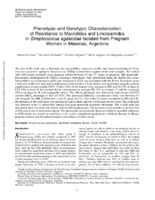Phenotypic and genotypic characterization of resistance to macrolides and lincosamides in streptococcus agalactiae isolated from pregnant women in Misiones, Argentina
Date
2020-12-03Author
Novosak, Marina Gisel
Bobadilla, Fernando Javier
Delgado, Osvaldo Daniel
Vergara, Marta
Laczeski, Margarita Ester
Metadata
Show full item recordAbstract
The aim of this work was to determine the susceptibility, molecular profile, and clonal relationship in Strep tococcus agalactiae (group B Streptococcus [GBS]) isolated from vaginal-rectal swab samples. We worked with 200 isolates collected from pregnant women between 35 and 37 weeks of gestation. The macrolide– lincosamide–streptogramin BMLSB) resistance phenotypes were determined using the double-disc assay. Susceptibility to erythromycin (ERI) and clindamycin (CLI) was performed with the E-test. Resistance genes ermB and ermTR were detected by polymerase chain reaction. Clonal studies were performed using the random amplification of polymorphic DNA. Twelve (6%) of the isolates were resistant to ERI and 10 (5%) of them to CLI. Fifty percent of the resistant strains corresponded to serotype III, 25% to serotype V, and the remaining 25% to serotype Ia, II, and nontypeable strains. The Cmlsb phenotype was detected in eight strains (66.67%) and the iMLSB phenotype in four (33.33%). The minimum inhibitory concentration values were between 1.5 mg mg/ and 16 /mL for ERI, and between 1 and 32 mL for CLI. Out of the 25 strains susceptible to ERI and CLI, the presence of the ermB gene was detected in eight of them and the ermTR gene in one strain. The ermB gene was detected in the 12 strains that initially had some macrolide resistance phenotype. The ermTR gene was detected in three out of the four strains with the iMLSB phenotype. The resistance to macrolides in the province of Misiones is due to multiclonal spread. The phenotypic and genotypic characterization of macrolide resistance in GBS strains are crucial to contribute to the correct intrapartum prophylactic antibiotic therapy of allergic pregnant women and the epidemiological surveillance of these strains.
Collections
The following license files are associated with this item:



